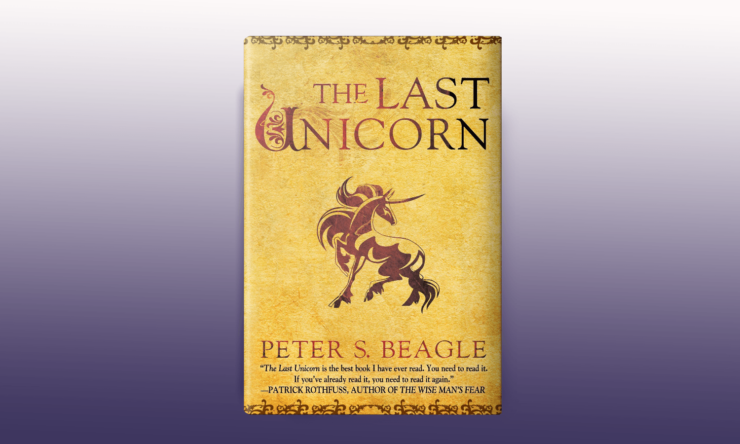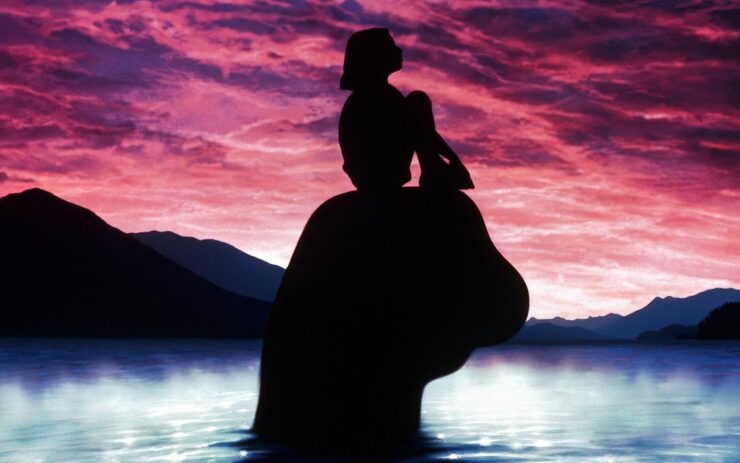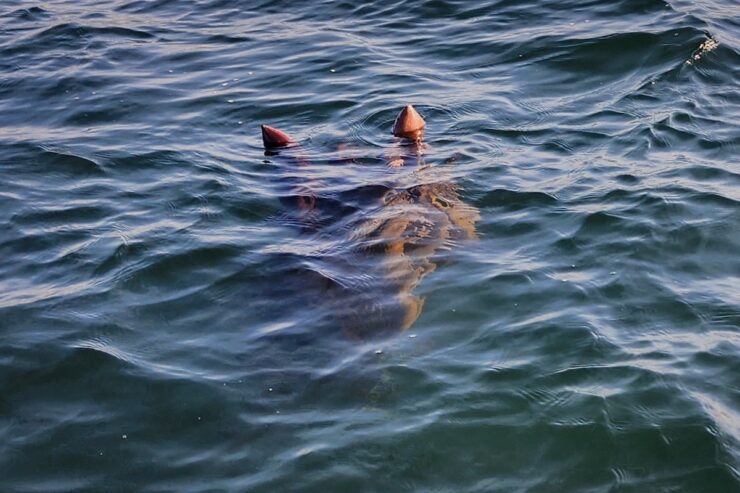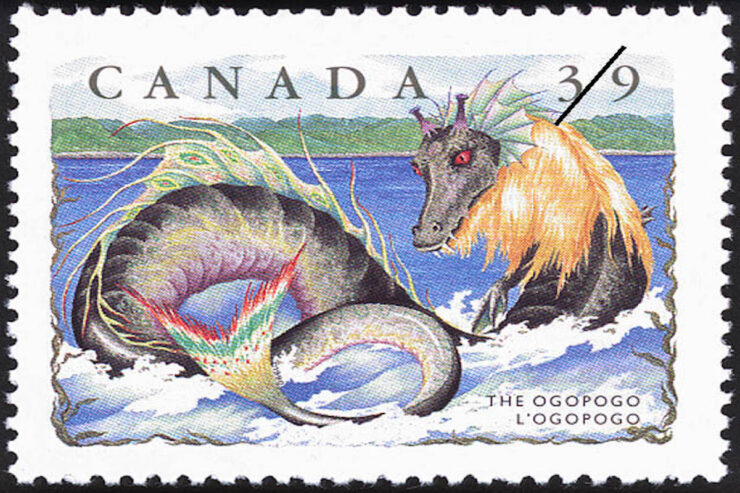Here are beauties which pierce like swords or burn like cold iron; here is a book that will break your heart…
C.S. Lewis wrote these words about Tolkien’s The Lord of the Rings, but they’ve always resonated with me when I think of Peter Beagle’s The Last Unicorn. Both are classics and both are splendid. I love them without moderation.
I’ve often reread Tolkien over the years, and of course the Jackson films and the new Amazon series have kept it front and center in the fantasy universe. Beagle’s much shorter novel has had one film, back in 1982, and the book has endured through the decades, though a series of unfortunate events has meant that the digital version could not be published until last week. That it’s still in print and still beloved is a testimony to its quality.
I had not reread it in many years. There’s always the fear when rereading a childhood favorite, that it won’t hold up. That it’s not as wonderful as one remembered.
It is. Oh, it is.
It’s a deceptively simple story. It begins in the mode of a fairy tale. The unicorn lived in a lilac wood, and she lived all alone. She’s immortal and magical; because of her presence, spring never leaves the wood.
One day she hears that she is the last. All the other unicorns are gone. No one knows where or how, but the world is empty of them, except in this one place.
This troubles her so much that she sets out on a quest to find out what happened to the rest of her people. It’s a long quest, and often a sad one. She quickly discovers that while animals and insects recognize her for what she is, humans can only see her as a white mare. They may feel something of her magic, but their eyes can’t see the truth.
Buy the Book
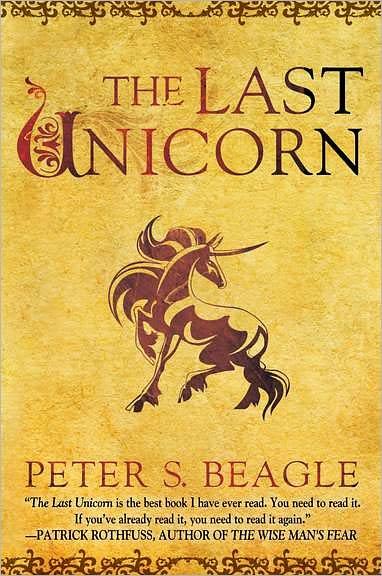

The Last Unicorn
This comes home to her in a very real and terrible way when she’s captured by Mommy Fortuna, the proprietor of the Midnight Carnival, which advertises Creatures of Night, Brought to Light. Most of the creatures on display are ordinary animals and one industrious spider, laid under an enchantment that deceives humans into seeing various mythical entities: the Midgard Serpent, the Manticore, the weaver Arachne. But one of them is real, the Harpy Celaeno, and now the unicorn, whom humans can finally see as herself—but only because of the witch’s spell.
It’s a subtle and beautiful and terrible thing, this disconnect between reality and illusion, and the human propensity to only be to able to see what’s truly real if they’ve been tricked into it. Mommy Fortuna weaves her illusions to make a living, but even more, she does it out of hubris. It’s this overweening ambition that leads her to trap the Harpy and then the unicorn. She knows that the Harpy will be her death—and that the unicorn will be a part of that. But she literally would rather die than set either of them free.
Among the humans who work the carnival is a particularly egregious misfit, Schmendrick the maladept. He studied with the greatest magician in the world, a mage so powerful that he was able to transform a unicorn into a man, though he never could reverse the transformation. Schmendrick is a near-total failure as a magician, able only to perform small tricks and sleight of hand, and he’s all too well aware of it. But he has a good heart, and he helps the unicorn escape from the Carnival, though he demands a price: that he accompany her on her quest.
The mismatched pair wander into the camp of Captain Cully, who is to noble bandits and merry bands as Schmendrick is to great wizards. Cully is a poor copy of Robin Hood, and his Maid Marian is the bitter, sharp-tongued, world-weary Molly Grue. The rest of the outlaws are equally grubby and antiheroic.
Schmendrick, called on to do tricks for Cully and his men, gets drunk and does something both wonderful and terrible. He opens himself to magic, and the magic comes. It conjures the reality of the myth, a vision of Robin Hood and his band.
The spell destroys Cully and his men, breaks them with the unbearable contrast between what they want to be and what they are. In the aftermath, Molly Grue joins the unicorn on her quest. Molly is furious at the unicorn for taking so unconscionably long to show up in her life, but can’t bear to be separated from her.
Their quest takes them at last to a grim and barren kingdom, the realm of King Haggard. Haggard is everything his name foretells. His servant, or his master—that’s never completely clear—is the Red Bull. It’s Haggard who has taken all the unicorns, and the Red Bull who rounded them up for him. But where they are, or what has become of them, no one knows.
The Red Bull comes to the travelers just before they reach Haggard’s crooked castle. He recognizes the unicorn, and he overwhelms her, dominates her and drives her toward his master (or servant). The humans are powerless to stop him.
But Molly is unrelentingly stubborn. She berates Schmendrick, demands that he do something. That he find some way to save the unicorn.
For the second time, he calls the magic and it comes. In its wake it leaves a terrible thing. A human woman, whom the Red Bull does not recognize as prey, and so he goes away.
Schmendrick has wrought the same great magic his master did. He has transformed an immortal and magical being into a mortal woman. She is appalled—“This body is dying,” she declares. “I can feel it rotting around me”—but there’s nothing he can do. He can’t turn her back.
And the travelers still don’t know where the rest of the unicorns are. So they continue to the castle, manage to talk King Haggard into taking them on—Schmendrick as court jester/stage magician, Molly Grue as housekeeper and maid of all work. The Lady Amalthea as they call her serves as a puzzle for the king to solve, and as an object of courtly love for the king’s young and callow heir, Prince Lír.
It’s Molly Grue who finds the key to the mystery of the Red Bull and the disappearance of the unicorns. But it takes all four of them, plus a magical ally or two, to conquer the Bull and bring down the castle and free the unicorns—and, last of all, to free the Lady Amalthea from her mortal captivity.
In the process, not only the unicorn is transformed. Molly has discovered life and hope even in this hardscrabble place. Lír has become a man and a king. And Schmendrick comes into his magic at last.
Schmendrick has a secret. He is immortal against his will. His master laid a spell on him: he cannot die until he finds his magic.
Schmendrick, born mortal, wants to be mortal again. The unicorn, born immortal, transformed into a mortal, also wants to return to her natural state. His meddling changes the changeless unicorn forever, whereas he can finally settle back into the person he was intended to be.
This is not a gentle story, in spite of its warmth and its deep heart. It touches on the very roots of fantasy, the nature of magic and the power of transformation. It’s about reality and illusion, mortality and immortality, and humanity with all its flaws and its delusions and the ways in which it lives and dies in the world, both the good it does and terrible damage it can do.
And it’s about beauty. What it is; what it means. The transformed unicorn’s great lament is not just that she is mortal, but that she is human. “A rhinoceros is as ugly as a human being, and it too is going to die, but at least it never thinks that it is beautiful.”
The unicorn in her natural shape is pure beauty. And so is the language of the book. Beagle is one of the great stylists of our genre. Just look at this:
There sat on an oaken perch a creature with the body of a great bronze bird and a hag’s face, clenched and deadly as the talons with which she gripped the wood. She had the shaggy round ears of a bear; but down her scaly shoulders, mingling with the bright knives of her plumage, there fell hair the color of moonlight, thick and youthful around the hating human face. She glittered, but to look at her was to feel the light going out of the sky.
And this:
With an old, gay, terrible cry of ruin, the unicorn reared out of her hiding place. Her hoofs came slashing down like a rain of razors, her mane raged, and on her forehead she wore a plume of lightning.
But this, too:
Beyond King Haggard’s castle, a burning brightness was rising, breaking into the night like a great shoulder. The magician stood erect, menacing the attackers with demons, metamorphoses, paralyzing ailments, and secret judo holds. Molly picked up a rock.
There is so much sheer bravura in the writing of this book. It balances high and singing fantasy with wit and humor—sometimes rather on the low side—and profound humanity. Its characters are real and flawed and complicated, and even its villains make their own kind of sense. The Red Bull is not evil. He’s just doing what he’s bound to do. The Harpy, who is evil incarnate, has excellent reason for her rage. She’s been tricked and captured, after all, and it’s her nature to exact bloody vengeance.
As for King Haggard, he is quite well aware of what he is. Unlike most humans, he has no illusions. He sees through the Lady Amalthea fairly soon, and lets the game play itself to its end out of ennui as much as anything. He is a man without joy, except for one thing. Unicorns are his happy place, insofar as happiness and Haggard can coexist in the same universe.
Many favorite books of one’s youth don’t make it intact into one’s maturity. For me The Last Unicorn not only survived, it showed itself to be even more wonderful than I had remembered. As a young reader I loved the words and the story and the characters. As an older reader and writer of my own books, I have a much clearer sense of what it takes to write a book of such beauty and power. It is wonderful in the true, old, magical sense: full of wonders. Marvelous. Immortal, like the unicorn herself.
Judith Tarr is a lifelong horse person. She supports her habit by writing works of fantasy and science fiction as well as historical novels, many of which have been published as ebooks. She’s written a primer for writers who want to write about horses: Writing Horses: The Fine Art of Getting It Right. She lives near Tucson, Arizona with a herd of Lipizzans, a clowder of cats, and a blue-eyed dog.










